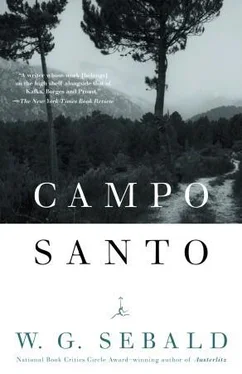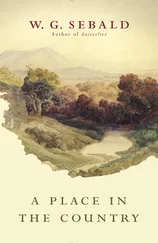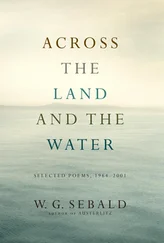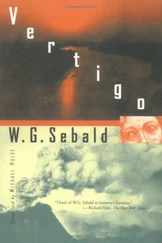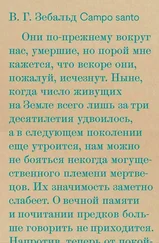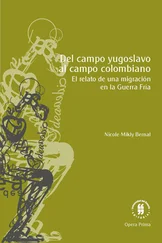La cour de l’ancienne école
After this picture was sent to me last December, with a friendly request for me to think of something appropriate to say about it, it lay on my desk for some weeks, and the longer it lay there and the more often I looked at it the further it seemed to withdraw from me, until the task, in itself nothing worth mentioning, became an insuperable obstacle looming ahead. Then one day at the end of January, not a little to my relief, the picture suddenly disappeared from the place where it lay, and no one knew where it had gone. When some time had passed and I had almost entirely forgotten it, it unexpectedly returned, this time in a letter from Bonifacio in which Mme Séraphine Aquaviva, with whom I had been corresponding since the summer before, told me that she would be interested to know how I had come by the drawing enclosed without comment in my letter of January 27, showing the yard of the old school of Porto Vecchio, which she had attended in the thirties. At that time, Mme Aquaviva’s letter continued, Porto Vecchio was a town almost dead, constantly plagued by malaria, surrounded by salt marshes, swamps, and impenetrable green scrub. Once a month at most, a rusty freighter came from Livorno to take a load of oak planks aboard on the quayside. Otherwise, nothing happened, except that everything went on rotting and decaying as it had for centuries. There was always a strange silence in the streets, since half the population was drowsing the day away indoors, shaking with fever, or sitting on steps and in doorways looking sallow and hollow-cheeked. We schoolchildren, said Mme Aquaviva, knowing nothing else, of course had no idea of the futility of our lives in a town made practically uninhabitable by paludism, as the phenomenon was called at the time. Like other children in more fortunate areas, we learned arithmetic and writing, and were taught various anecdotes about the rise and fall of the Emperor Napoleon. From time to time we looked out of the window, across the wall of the schoolyard and over the white rim of the lagoon, into the dazzling light that trembled far out over the Tyrrhenian Sea. Otherwise, Mme Aquaviva concluded her letter, I have almost no memories of my schooldays, except that whenever our teacher, a former hussar called Toussaint Benedetti, bent over my work he would say: Ce que tu écris mal, Séraphine! Comment veux-tu qu’on puisse te lire? (How badly you write, Séraphine! How do you expect anyone to read that?)
Strangeness, Integration, and Crisis: On Peter Handke’s Play Kaspar
We must therefore listen attentively to every whisper of the world, trying to detect the images that have never made their way into poetry, the phantasms that have never reached a waking state. No doubt this is an impossible task in two senses; first because it would force us to reconstitute the dust of those actual sufferings and foolish words that nothing preserves in time; second, and above all, because those sufferings and words exist only in the act of separation.
MICHEL FOUCAULT, MADNESS AND CIVILIZATION
When, after several panic-stricken attempts, Kaspar emerges onstage from behind the backdrop of a curtain, and at first does not move from the spot in that strange space, “he is the incarnation of astonishment.” 1At the end of what seems to us to have been a long flight he finds himself in a clearing, hemmed in without any way of escape, delivered up to a reality of which he has no concept. He knows nothing about us. It may be that in his colorful jacket, wide trousers, and hat with its band he reminds us of the wide-eyed rustics who used to make Viennese audiences laugh. As wily provincials, these rustics of course knew their way around, not perhaps in urban society “comme il faut” but onstage, where they were never at a loss for either information or an excuse. But Kaspar is still a stranger here and has no companions. The theme of the play, then, is not the fast-moving adventures of the comic character, which are happily resolved in the end, but the inner and inward-looking story of the taming of a wild human being. The result, however, is to cast a critical light on what the development of the outer plot constantly implies in its specific and historical course: the transformation of the unruly clowning into a proper Kasperl play, the attempt, in many ways a hopeless one, to turn an individual who by ordinary standards is uncivilized into a respectable citizen. [6] The Kasperl play is the German version of a Punch and Judy show.
We have to make do with conjectures about Kaspar’s previous life. The novel by Jakob Wassermann tells us that “no one knew where he hailed from,” and that he himself, being incapable of language, could give no information about his origins. 2However, his unheralded, defenceless presence signifies the living provocation of social resentment. We suspect that the speechless creature, as yet entirely untaught, is in possession of a secret of his own, if not actually in a state of paradisal bliss. And that, says Nietzsche, perspicacious in such matters, “is hard on a man. He may ask the animal: ‘Why do you just look at me instead of telling me about your happiness?’ The animal wants to reply: ‘Because I always immediately forget what I wanted to say’—but then it forgets even this answer and says nothing.” 3It is rather like that with Kaspar and his prompters in the play. They envy him the blankness of the life he represents, his ability — to quote Nietzsche again — to be “totally unhistorical.” 4At the same time, this special quality is the reason for Kaspar’s strangeness. Hofmannsthal has linked similar conjectures with his concept of “pre-existence,” a state of painlessness beyond trauma in which a barely perceptible happiness, which is mere and simple existence, persists uninterrupted. Wassermann’s novel, too, tries to present this state as something very different from the deprivation of imprisonment. “He did not sense any changes in his own physical condition,” says Wassermann of Hauser, “or wish for anything to be different.” 5Kaspar’s placid existence is illustrated in the symbol of a “white wooden horse … that mirrored his own existence darkly.… He did not talk to it, not even in silent imagined exchanges, and although it stood on a board that had wheels it never occurred to him to push it to and fro.” 6From such a static existence, a life without a history in which one might acquire the art of hearing “wood rotting over long distances” and in which “Caspar could make out colours even in the dark,” he is released into the light of the stage, a shocking and painful transition to surroundings that are qualitatively entirely new, where the “originally prestabilized harmony” is lost and his inner resources prove inadequate. 7Anthropological theory assumes that exposure in a treeless situation where all escape upward was cut off led to the invention of myths. Kafka’s ape, dragged into human society, expresses very similar ideas in his “Report for an Academy.” It is the absence of any way of escape that has forced him to become human himself. “I had always had so many ways out, you see, and now I have none.” 8So the wild boy Kaspar has no choice but to develop, except that in his case, as in the ape Rotpeter’s, the myth does not have to be invented: it is provided for him by his professional prompters. Their disembodied voices have little to do with the optimistic educational theories of the eighteenth century and later, according to which it might be hoped that Caspar Hauser would educate himself to become a liberated, guiltless human being, a natural wonder. If such experiments showed naïve idealism, the general approach to Kaspar resulted only in an illusion of liberation, entirely adapted to existing circumstances. An ego is formed until finally, as Hofmannsthal described it, it slips into another identity, “like a dog, eerily silent and strange.” 9
Читать дальше
